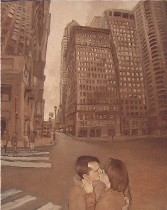 Gallery owner Rodger LaPelle of his eponymous gallery starts his conversations with the good-news headlines, then bad news in detail, and then back to the good news, maybe not in great detail, but still there. Some of his good news includes the recent sale of his 50th piece by young painter Matt Bollinger who had a solo show at LaPelle’s in February. LaPelle also wanted me to know about a commission he brokered for another of his artists.
Gallery owner Rodger LaPelle of his eponymous gallery starts his conversations with the good-news headlines, then bad news in detail, and then back to the good news, maybe not in great detail, but still there. Some of his good news includes the recent sale of his 50th piece by young painter Matt Bollinger who had a solo show at LaPelle’s in February. LaPelle also wanted me to know about a commission he brokered for another of his artists.
Then there was the bad news. It’s August; he hasn’t sold quite as many paintings as he would have liked this month; his stuff (especially the David Lynches) do better on ebay than on artnet.com, and the art market is therefore falling apart.
As proof of the art market disaster, LaPelle said eight Philadelphia galleries closed this summer. Here’s his list–Hahn in Chestnut Hill, Mangel, Charles More, Union 237, Well Fed Artists, Pink Bridge, Pringle, Silicon Gallery–and he hears Indigo may lose its space, thanks to a new landlord.
CORRECTION: Rodger’s list is not quite accurate. I just had a chat with Rick DeCoyte of Silicon Gallery, and it appears it is alive and well. I know that several of these are indeed out of business–More, Union 237 as previously reported here in artblog, Well Fed Artists and Pringle, also as previously reported. I called Hahn Gallery and learned from the recorded message that the gallery has indeed closed its space on Germantown Avenue, although they are still dealing out of an apartment at the Philadelphian apartment house according to the gallery’s phone message. I cannot vouch for Mangel, where the phone message says it’s reopening Sept. 13. If I get more info, I’ll add it.–08/26/05
I’m not sure this list proves much. Here are a few reasons. Mangel has been retiring forever. More was beset with other problems. Union 237’s business plan was a non-starter. Well Fed Artists Gallery was a sweet little hole-in-the-wall coop with a shaky business plan. Pink Bridge was (is?) a vanity gallery. I don’t know why the other three went out of business, but maybe it did have something to do with the art market.
LaPelle was the second person who complained to me in one day about people in the Philadelphia area with lots of money who say they can’t afford the price of a $2,000 or $3,000 painting. The other was Liz Afif (see previous post on the art now up there).
Here’s what they are saying: If you’re driving around in an SUV and feed it regularly at the pump these days, you can afford original art. You just need to rethink how you allocate your cash. Art deserves a bigger cut in your budget, and when it hangs on your wall, it lasts and lasts. So buy it. Better yet, buy it in Philadelphia.
LaPelle intoned his list of gallery failures all the while that Bill Ryan, a painter who took off 20 years from painting to run a florist’s shop in Abington, was explaining his own dream of opening a gallery. Amazingly, Ryan seemed undeterred by LaPelle’s litany of bad news.
Then in walked Matt Bollinger, he of the 50 paintings, and his friend Rachel Frank, who had just returned from Skowhegan, and the mood in the gallery lifted with their youthful prospects. This was a typical day at LaPelle. Oops. Better take time out to look at the art.
On the walls at LaPelle were some paintings from Simon Huelsbeck and Marcus Michels.
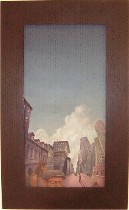 Huelsbeck (see a post from Roberta about his last show at LaPelle here) has been moving away from his sepia-toned, stylized urban spaces to full color and to somewhat different subject matter. The sense of lost memories is still there, but these in-color memories are about vertigo, childhood and a lack of control, a sense of falling, instability, and dislocation (top, “Intersection”).
Huelsbeck (see a post from Roberta about his last show at LaPelle here) has been moving away from his sepia-toned, stylized urban spaces to full color and to somewhat different subject matter. The sense of lost memories is still there, but these in-color memories are about vertigo, childhood and a lack of control, a sense of falling, instability, and dislocation (top, “Intersection”).The cinematic/photographic spin may have changed, but the surrealism remains amid a tilt toward apocalypse.
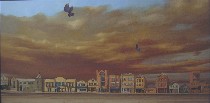 The less realistic these paintings are, the more I like them. I love the loopy clouds in “All the World is a Stage.” The three figures in “A Day on Earth” (right above) seem at once isolated and part of a miniature Day of the Locusts crowd, as the fish-eyed buildings threaten to fall.
The less realistic these paintings are, the more I like them. I love the loopy clouds in “All the World is a Stage.” The three figures in “A Day on Earth” (right above) seem at once isolated and part of a miniature Day of the Locusts crowd, as the fish-eyed buildings threaten to fall.
The figures falling from the threatening sky in “My Ashland” (above left) are hanging from ropes. Nonetheless, they bring to mind 9/11 and the loss of a sense of security even in that small town. And in “Parade Flight (Astray)” the teddy bear float is hovering over shards of civilization–broken concrete or pieces of statues (right below, “Parade Flight (Astray)).
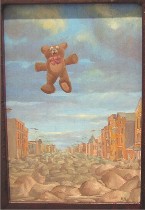 In a less reflective mode, painter Michels offers snapshots of the young and the restless spending endless hours hanging around. The smaller canvases feel like sketches crowded with too many details. Why are all those stacks of books and things included in the paintings, I wondered. But the bodies strewn across chairs in odd ways entrance Michels’ eye.
In a less reflective mode, painter Michels offers snapshots of the young and the restless spending endless hours hanging around. The smaller canvases feel like sketches crowded with too many details. Why are all those stacks of books and things included in the paintings, I wondered. But the bodies strewn across chairs in odd ways entrance Michels’ eye.
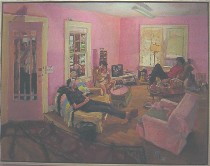 Michels’ palette of bubblegum pink and light ochre yellow hits its stride in some of the larger paintings that have not quite so much junk included in every scene. The big ones also have some sense of mystery.
Michels’ palette of bubblegum pink and light ochre yellow hits its stride in some of the larger paintings that have not quite so much junk included in every scene. The big ones also have some sense of mystery.
In “Sunday Morning” (left above) the lounging apartment dwellers are awakened from their poses of ennui and exhaustion by a couple of Mormons at the door (you know, young men dressed unnaturally formally in black pants and tie and white shirts). I loved the subject matter here, the two societies with different values.
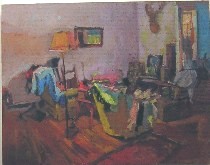 In “Winter” (right) two chairs beneath the glowing lamp are draped in brightly colored afghans. The sense of heated rooms and too much time spent indoors and early darkness are nicely captured. I think this was my favorite of the paintings for the wild colors and the thick atmosphere.
In “Winter” (right) two chairs beneath the glowing lamp are draped in brightly colored afghans. The sense of heated rooms and too much time spent indoors and early darkness are nicely captured. I think this was my favorite of the paintings for the wild colors and the thick atmosphere.
But mostly Michels never met a figure he didn’t want to paint.
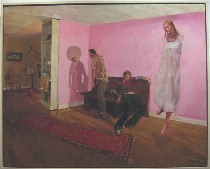 In “The Annunciation,” (left) a floating blond in a virginal nighty and a dark shadow bracket an unhappy couple. Anyone can make up some stories for this one.
In “The Annunciation,” (left) a floating blond in a virginal nighty and a dark shadow bracket an unhappy couple. Anyone can make up some stories for this one.
When Michels leaves room for stories and speculation, the paintings rise above just unedited bric-a-brac. The best of the paintings have some ambiguity even as they stay natural and stay close to what Michels seems to like best–Gen Y hanging out with the clutter.









